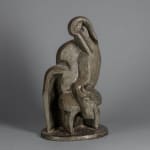Jacques Lipchitz 1891-1973
38.5 x 22 x 17 cm
At the beginning of World War II, Lipchitz fled from the Nazis and ended up in the US, leaving behind a less abstract style and, in a major career-changing transformation, he began producing larger scaled sculptures in bronze. He settled in New York City where his work became increasingly emotionally expressive. Today, he is regarded as one of the foremost contributors to the Cubist movement and to modern sculpture.
Seated Bather was conceived two years after Seated Woman in Armchair and was actually created in direct response to Seated Woman in Armchair, Lipchitz explains his thought process behind the piece:
‘There is a small Seated Bather (1923) which I think indicates some of the ideas I have been discussing. This is a figure seated in an armchair. It reflects some of those ideas I was concerned with involving the complete integration of a human figure with an object whether it was the harlequin or Pierrot with guitar or the woman in a chair. The sculpture emerges from the very abstract maquette of Seated Woman in Armchair I made in 1921, but now the figure of the woman-chair takes on a specific personality, a spirit of humanity. To me, as I look at it now, it has a kind of tenderness, not unrelated to late medieval conceptions of the Madonna and Child, although I know that at the time I made it I was thinking of nothing like this. This is, as I said, a small sculpture but it is quite complete, an assimilation of the figure to the object, easily and completely realised in the round. When I made it on this small scale, I knew it was complete; there was nothing further I could do; there was no point in attempting to enlarge it, to make it monumental, so I simply left it as it was.’
Although a clear connection can be made between the two pieces, there are some distinct differences such as how the chair relates to the figure in both. In Seated Woman in Armchair the figure is being enveloped by the chair whereas the figure emerges from the chair in Seated Bather. This small difference changes how the viewer interprets the figure; in the earlier sculpture the figure seems passive and perhaps guarded by the chair; however the bather conveys a sense of energy, rising above the chair. Lipchitz relates the bather to Madonna and Child and says that it has a ‘kind of tenderness’ however, while Madonna is often depicted as a tender, compassionate figure there is undeniably a sense of power conveyed through her.
Seated Bather is less surreal, Lipchitz describes the earlier sculpture as ‘the woman-chair’ the chair has been given human qualities such as eyes which sit at the top of the sculpture however the chair in Seated Bather is much more apparent as an object even though the forms are fused together.
Provenance
Sam & Ayala Zacks, TorontoAyala Zacks Abramov, Tel Aviv & Jerusalem, and thence by descent to the present owners
Private collection, UK
Literature
M. Raynal, Jacques Lipchitz, Paris, 1947 (the terracotta version illustrated n.p.; dated '1924');A. G. Wilkinson, The Sculpture of Jacques Lipchitz, A Catalogue Raisonné, Vol. I, The Paris Years, 1910-1940, New York, 1996, no. 168, p. 219 (another cast illustrated p. 68);
K. de Barañano, Jacques Lipchitz, The Plasters, A Catalogue Raisonné, 1911-1973, Bilbao, 2009, no. 98, p. 178 (the plaster version illustrated);
J. Lipchitz, My Life in Sculpture, (New York, Viking Books: 1972) p. 76




